Table of Contents
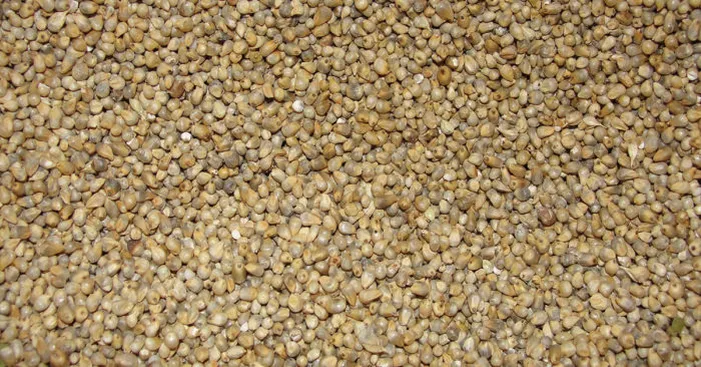
Milo seed has become a popular health food choice in recent years due to its many benefits.
Not only is it packed with beneficial nutrients, but it also has a pleasant nutty taste, making it a great addition to smoothies, cereals, and other dishes.
In this blog post, we‘ll delve deeper into the world of milo seed, exploring its nutrition, health benefits, and how you can incorporate it into your diet.
Milo seed: overview
So, if you‘re looking for a nutrient–rich food that can add a delicious flavor to your meals, milo seed may be just what you‘re looking for!
milo seed, Sorghum seed or milo grain, three names used to for the same cereal grain.
However, the more general word is Sorghum, which comes from the Italian word “Surgo” even though the seeds are of African origins. (1)
These grains grow on grasses and they are part of the Poaceae family, one of the oldest cereals alongside wheat. (2)
Tracing back in history, milo seed is used to be essential in the diet of ancient Egyptians and Sudanese 10,000 year ago.
Even though the milo seed grows in most of the continents, the yield production differs based on the region.
In Jordan for example, the yield production almost 13 tonnes per hectare, which is 10 times that of the world’s annual yield.
Nowadays, USA is the biggest producer of sorghum seeds with up to 75% of the global production. (3)
Milo seed: around the world
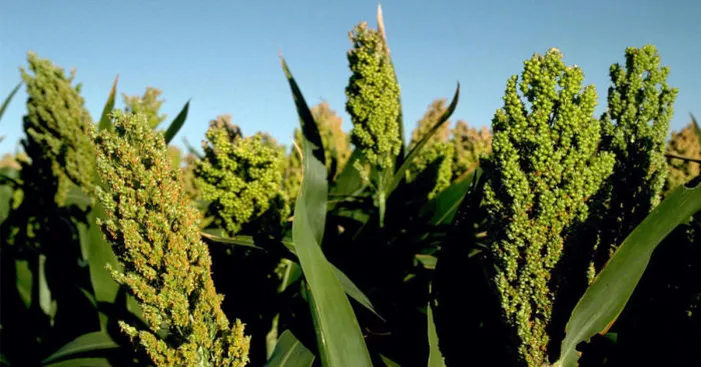
Sorghum is a type of grass native to Ethiopia, where people grow it for both human and animal consumption. (4)
The stems of a sorghum plant can grow up to 16ft (5 meters) in height for some varieties.
In fact, there are many different types of milo seed allowing multiple uses: popcorn, animal food, beer, dye…
Also, it can be consumed in many different ways such as: couscous, pancakes, breakfast cereals…
Nonetheless, sorghum is very easy to grow which makes it the cereal of most of the third world countries.
This is thanks to its deep roots system, the plant can supply itself with the mineral sources in the soil.
As a result, sorghum doesn’t require much water or fertilizer to support heat.
It is an exceptionally drought resistant cereal and that is why it is cultivated widely in India, the Americas, and Africa.
Depending on the continent, it earned many names such as “Indian millet” in Asia, “big millet” in Africa, and “Egyptian wheat” in the Middle East.
Even though, Americans mostly use sorghum to feed birds, today you will learn how to cook it and enjoy all of its health benefits.
Milo seed nutritional data and benefits:
Milo seed (sorghum) nutritional data:
The following information counts for a 200g (7 ounces) of cooked sorghum seeds: (5)
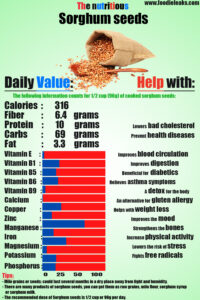
- Calories: 316
- Protein: 10g
- Carbs: 69g
- Sugar: 2.4g
- Dietary fibers: 6.4g
- Fats: 3.3g
- E vitamin: 3%
- B1 vitamin: 27%
- B3 vitamin: 22%
- B6 vitamin: 25%
- B9 vitamin: 5%
- Calcium: 1%
- Copper: 30%
- Zinc: 15%
- Manganese: 67%
- Iron: 18%
- Magnesium: 38%
- Potassium: 7%
- Phosphorus: 22%
- Selenium: 21%
Milo seed health benefits:
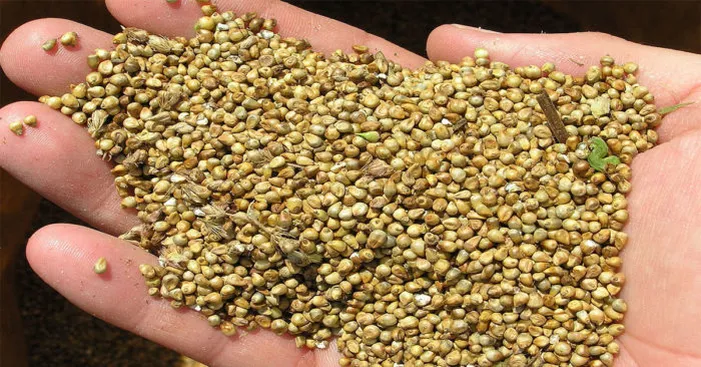
From a health perspective, sorghum seeds deserve all of our interest.
To start with, these grains are gluten free which makes them suitable for people who are allergic to gluten. (6)
In addition, they are very rich in minerals especially in iron, phosphorus, calcium and magnesium.
Improves cardiovascular health:
Everyone would agree that there is a tight link between all grains and heart health which also applies to sorghum seeds!
In fact, these seeds are rich in magnesium which is a mineral that contributes to lowering blood pressure. (7)
By reducing blood pressure and lowering cholesterol in the blood, consuming milo seed reduce the risk of heart diseases.
Lowers bad cholesterol:
Just like quinoa, chia and sesame seeds, milo seeds are very rich in fibers which help to lower bad cholesterol.
Once the dietary fibers reach the stomach, they turn into a gel form that stick into the walls of the stomach and reduce the absorption of bad cholesterol into the body.
There are some studies that also confirms the effect of sorghum lipids in lowering cholesterol levels. (8)
Improves blood circulation:
One of the minerals that is abundant in milo seeds is potassium, which help to lower blood pressure.
In fact, one of the key roles of potassium is that it dilates blood vessels which result in a better blood circulation. (9)
Improves digestion:
Once you consume milo seeds regularly, they will eliminate bloating and reduces the risk of constipation and cramps. (10)
Also, thanks to the abundance of fibers in sorghum seeds they help to relieve stomachaches and improve the health of the liver and kidneys.
Beneficial for diabetics:
The magnesium in milo seeds not only help to lower blood pressure, but that also results in lowering blood sugar level.
In one of the studies, it was shown that magnesium is specifically beneficial for people with type 2 diabetes. (11)
A detox for the body:
Other abundant nutrient in milo seeds are antioxidants and phenol which both can remove toxins from the body.
Those phenols in milo seeds including vanillic acid, gallic acid, ferulic acid helps the body in its fight against free radicals. (12)
As a result, our bodies are less vulnerable to intoxications that can affect the activity of enzymes.
A good replacement for those with gluten allergy:
Whether you want to consume cereals or make bread, milo seeds can replace wheat for people with gluten allergy. (13)
Milo seed also contains gluten proteins but it is very little compared to the content in wheat.
Helps with weight loss:
Due to its high content in dietary fibers, milo seeds gives a longer feeling of fullness and less desire to snack. (14)
This results in a lower consumption of junk food which is the main reason for weight gain.
Also, in the same sense, you can use sorghum sweeteners as a healthier alternative to the traditional ones.
Improves the mood:
Sorghum is rich in vitamin B6, which is essential in the production of GABA ( a neurotransmitter: gamma-aminobutyric acid) in the body. (15)
This GABA neurotransmitter have the ability to regulate nerves impulses in our bodies.
A sufficient production of GABA improves the concentration and the mood, lower the risk of depression and reduces stress.
Strengthens the bones:
We always link bone health with calcium and that is totally correct!
However, it is not just calcium, magnesium also contributes to the well-being of our bones.
In fact, one of the many roles of magnesium is that it will help our bodies absorb calcium more efficiently. (16)
To strengthen your bones, consider including sorghum seeds to your diet by following our cooking ideas in the next part.
Consuming milo seed (sorghum seeds):
It is not just about the many health benefits, but also the many possibilities of using this seed in the kitchen.
This is thanks to the many products of sorghum seeds, you can get them as raw grains, milo flour, sorghum syrup or milk.
In the next parts we are going to suggest many recipe ideas on how to use these different milo products, let’s start:
Sorghum grains:
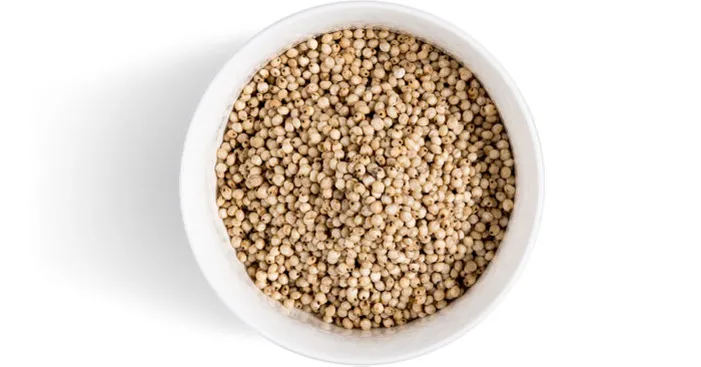
Sorghum grains can easily replace wheat or even rice as you can cook it in the same way, and then use it in many recipes. (17)
How to cook sorghum grains?
In order to cook sorghum seeds, you don’t have to be in the kitchen during the whole process, there are few easy steps to follow:
- Wash the sorghum seeds in water to remove any impurity.
- Put the seeds in 3 times their volume of cold salted water and bring them to boil.
- When the water start boiling, Cover it and reduce the heat to medium, and let it cook for 45 minutes.
- After that time, the sorghum grains must be soft and if they are not let them cook for an additional 5 minutes.
- Drain the water and your grains are ready to be used.
How to consume them?
After you cook milo seeds in the same way you cook rice or wheat, you can use it for both sweet and savory dishes including:
- Mijoté with tomatoes and eggs.
- Vegetable salads: you can serve the boiled or steamed sorghum grains with chopped tomatoes, cucumbers, feta cheese and olives.
- You can use the cooked milo seeds by pan-frying them alongside garlic, onion and zucchini and serve like Risotto.
- To make a gluten-free Buddha bowl. (18)
- To replace Semolina in a gluten-free couscous. (19)
- To make sorghum porridge, by cooking the grains in water beyond 45 minutes, until they become like rice pudding. (20)
Sorghum milk:
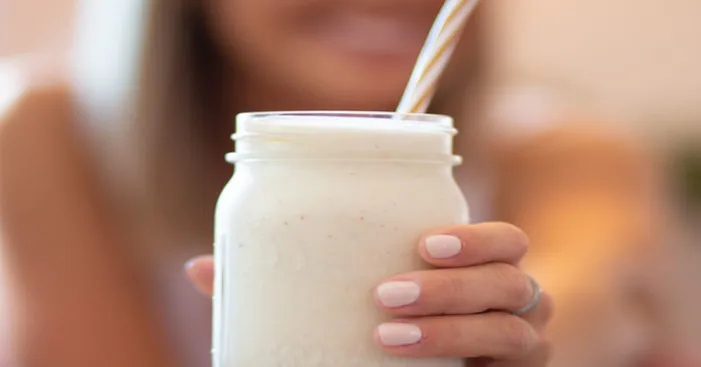
This probably sound very exotic, but it is actually a very easy to make vegan drink.
Basically, it is sorghum seeds blended in 3 times their volume in water to obtain a gluten-free and lactose-free vegan drink.
How to consume them?
Just like the name suggest, you don’t have to be a vegetarian or vegan to use sorghum milk as it can replace cow’s milk in any recipe. (21)
You can drink it in your breakfast, or even use in your pancakes and pastry recipes.
Sorghum flour:

In some parts of the world, people have learnt traditions from their ancestors in order to extend the lifespan of their food.
One of those techniques is to blend the milo seeds to obtain a flour that is rich in protein, gluten-free and easy to digest.
Depending on the type of sorghum used, its flour can be either pinkish brown, grey or brownish white with a sweet taste.
How to consume them?
Basically, you can use sorghum flour as a replacement of the wheat flour to make cakes, pastas, cookies, pancakes…
To make the composition easier to cook with, it is best to mix this flour with 60% of other gluten free flour such as rice flour.
This type of flour is probably not very famous in the United States, but in the Tunisian cuisine they use it to make:
- Tunisian Ghraiba and cakes. (22)
- Gluten-free pancakes.
- To make Droô, which is a cream made from sorghum flour and water or milk cooked together, then topped by almonds or hazelnuts. (23)
Sorghum syrup:

Sorghum or milo syrup is a type of dark syrups or Molasses, made from the stems and stalks of the plants not its seeds. (24)
In the global scale, this syrup is really difficult to find because it is mainly an American product.
How to consume them?
For people who are allergic to gluten, this syrup can replace sugar in any sweet recipes. (25)
Also, sorghum syrup can replace agave nectar or maple syrup topping crepes and pancakes for example.
Pop-sorghum or pop-milo:
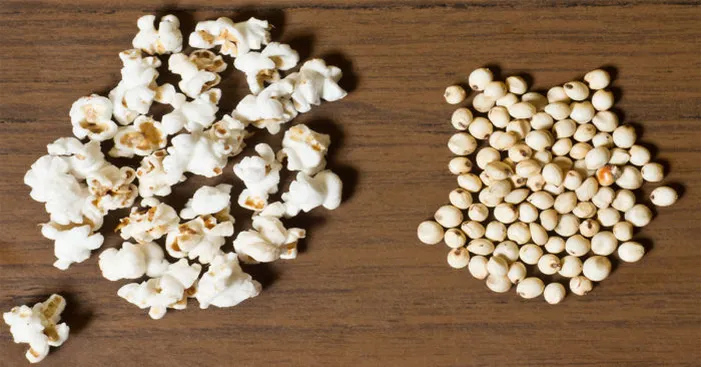
Another surprising fact about milo seed, is that you can pop it like popcorn! (26)
In order to do this, you just fry them in an oiled pan while covered until the grains pop.
How to consume them?
You can use the popped sorghum seeds by adding them to your breakfast muesli with oatmeal.
You can also incorporate the popped milo seeds in salads and gratins to add some crunchiness.
Precautions and side effects of milo seed:

Despite all the health benefits of sorghum seeds its consumptions must always be moderate.
This is because it is considered a superpower seed and an excessive consumption may cause overdose of certain contents such as:
Eating too much sorghum seeds may inhibit the absorption of iodine due its high content in glycosylflavone. (27)
This plant-based compound interferes with the thyroid hormones production which may lead to a malfunction of the thyroid gland.
Sorghum seeds can lead to an anaphylaxis reaction, which causes digestive complications and low blood pressure which leads to a severe respiratory symptoms. (28)
There are few precautions associated with the consumption of milo seed such as:
Milo seed intolerance:
Milo seed contains Zein, which is a type of protein that belongs to the gluten protein that you can also find in wheat. (29)
For those who suffer from wheat allergy (celiac disease) once they consume this protein they have allergic complications.
These complications causes several symptoms from bloating, diarrhea, fatigue and weight loss.
In 2005, the Gut Journal published a study in which it indicated that zein protein in milo seed can cause allergies for wheat allergic people. (30)
However, it also claimed that the severity of the inflammations from milo seed allergy is less than that of wheat.
Decrease the absorption of some nutrients:
The milo seed contain phytic acid, which reduces the absorption of certain minerals including zinc and iron. (31)
Even though its consumption will not cause problems for those who follow a balanced diet since it contains most nutrients.
Although, it can be harmful for people who have a diet that relies on grains and legumes.
You shouldn’t be concerned about this, as there are several tricks we can do to reduce the content of phytic acids in milo seed.
For instance, soaking milo seeds in water for half an hour, sprouting them, or fermenting them reduces their content in phytic acids. (32)
May raise blood sugar:
Milo seeds are starchy and that means they contain sugar and carbs that may increase blood sugar levels.
Nonetheless, in the absence of excessive sugar intake in the diet, consuming milo seeds is healthy.
In addition, it is also completely safe for diabetic people to consume milo seeds in moderate portions.
How to store sorghum?

Milo seeds exist in many form as you can get milo seeds, milo flour and milo syrup.
Here are our tips on how to store different sorghum products:
- Milo seeds or grains: just like quinoa or rice, it lasts several months in a dry place away from light and humidity.
- Milo flour: it can last for too long in its original packaging but once opened, it’s better to transfer it into an airtight container.
You can find the shelf life of milo flour on the package.
- Milo syrup: generally, if not opened syrups can last between 1 and 3 years depending on the storage conditions.
However, milo seeds syrup can keep its flavor and freshness for 1 year in the refrigerator.
References:
(1): The History of Sorghum | Kansas Farm Food (kansasfarmfoodconnection.org)
(2): Poaceae | Definition, Characteristics, Species, Classification, Uses, & Facts | Britannica
(3): Export Sorghum – Sorghum Checkoff
(4): Sorghum breeding in Ethiopia: Progress, achievements and challenges (peertechzpublications.com)
(5): Sorghum grain nutrition facts and analysis. (nutritionvalue.org)
(6): Sorghum, a healthy and gluten-free food for celiac patients as demonstrated by genome, biochemical, and immunochemical analyses – PubMed (nih.gov)
(7): The role of magnesium in hypertension and cardiovascular disease – PubMed (nih.gov)
(8): Grain sorghum lipid extract reduces cholesterol absorption and plasma non-HDL cholesterol concentration in hamsters – PubMed (nih.gov)
(9): Potassium lowers blood pressure – Harvard Health
(10): Impact of Grain Sorghum Polyphenols on Microbiota of Normal Weight and Overweight/Obese Subjects during In Vitro Fecal Fermentation – PMC (nih.gov)
(11): Magnesium and type 2 diabetes – PMC (nih.gov)
(12): Phenolic Compounds in Whole Grain Sorghum and Their Health Benefits – PMC (nih.gov)
(13): Celiac disease: in vitro and in vivo safety and palatability of wheat-free sorghum food products – PubMed (nih.gov)
(14): Nutrition Tips For You: Millets For Weight Loss – Sorghum (outlookindia.com)
(15): Scientists reveal vitamin B6 supplements may reduce anxiety and depression : The Tribune India
(16): Magnesium essential for absorption and metabolism of vitamin D and calcium (news-medical.net)
(17): Wholly Grain Sorghum: A Healthier Rice Alternative – Mommy Plannerista
(18): Sorghum Buddha Bowl Recipe (allrecipes.com)
(19): The 5 Best Substitutes For Couscous | Americas Restaurant
(20): Sorghum-porridge/
(21): Soy – Sorghum Milk as a Functional Drink Source of Antioxidants Fadly D, Tulaseket F, Rahmawati R, Sakriawati M, Putriana AE, Septiyanti S, Mujahidah FF, Wirawanti IW, Suherlin N, Febristi A, Muttalib YS – Int J Nutr Pharmacol Neurol Dis (ijnpnd.com)
(22): Ghraiba Homs – Traditional Tunisian Recipe | 196 flavors
(23): Tunisian sorghum pudding (red-violet.com)
(24): What Is Molasses? (thespruceeats.com)
(25): Does Sorghum Syrup Go Bad? How to Substitute It – Higher Edukitchen
(26): How to Pop Sorghum + Spiced Sorghum “Popcorn” Recipe (zestfulkitchen.com)
(27): Identification of flavone phytoalexins and a pathogen-inducible flavone synthase II gene (SbFNSII) in sorghum – PMC (nih.gov)
(28): Cross-reactivity between aeroallergens and food allergens – PMC (nih.gov)
(29): Properties of heat-treated sorghum and maize meal and their prolamin proteins – PubMed (nih.gov)
(30): Maize Prolamins Could Induce a Gluten-Like Cellular Immune Response in Some Celiac Disease Patients – PMC (nih.gov)
(31): 4 Foods High in Phytic Acid and Why You Should Avoid It (webmd.com)
(32): Effect of germination on the phytase activity, phytate and total phosphorus contents of rice (Oryza sativa), maize (Zea mays), millet (Panicum miliaceum), sorghum (Sorghum bicolor) and wheat (Triticum aestivum) – PubMed (nih.gov)
(33):
